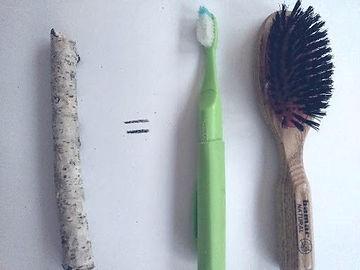Cross Curricular

In his video, Changing Education Paradigms, the late Sir Keith Robinson mentioned that as children grow older, they become more rational, but less creative. For this reason, teachers must try to bring creativity-boosting activities into their classrooms.
The character in “Not a Stick,” by Antionette Portis, insists that what is in his hand is anything but. It's a sword or a paintbrush, but not a stick.
That is the inspiration behind this activity.
Someone might use the stick like a paintbrush and the next one in line will feign brushing her hair or teeth. The fourth and seventh learner might just shrug their shoulders and say “I don't know”.
In this post, we'll look at ways of making this activity more effective for different levels, scaffolding creativity and providing more opportunity for language.
Pass the stick adaptation 1: Making the options clear
We usually start the activity with a teacher demonstration to show different ways of using the stick and to get the learners’ imagination rolling. To go one step further we can provide a framework, such as a picture of a house with the different rooms and pictures of things the stick might be in each or a table with the different categories for the options: sports materials, parts of instruments, classroom equipment, tools and kitchen utensils, for example.
Pass the stick adaptation 2: Adding some memorisation
We are already using up our “brain power” by thinking of new ways to use the stick and the learners will now be told to remember what their classmates have done. That is why the only thing we say when we have the stick in our hand is “I can use the stick like this.” Once five learners have had a go, we repeat those actions. Again, the language is simple: “He/She can use the stick like this.” We don’t want to stop the flow with questions about how to say something or memorising more complex structures.
Pass the stick adaptation 3: Enhancing the language
Language teachers will wonder how to get more out of this activity. First of all, the frameworks provided at the beginning help to revise lexis and, for older learners, to find ways of describing what they don’t know how to say by using relative clauses.
After the whole class has had a go, and we have revised chain-fashion what each has done by miming their actions and saying “She/He uses the stick like this,” we draw stick figures and add captions, depending on the level. The most basic levels will use present continuous or simply say where that person is in or outside the house, according to the action. And we can step up the level by writing in the past or past continuous.
Going further
We could change the object, using a book, spoon or, as in the Robinson video, a clothes peg. Another idea is to think of how many sounds learners can produce with their hands or another part of their body. This can lead to a body percussion or cup turning routine: how can we accompany the songs we like in English? The next option is to choreograph a simple dance, the task behind a typical summer camp dance, like Little Sally Walker.
We might consider taking an older class back to Pre-school to see how well they rise to a similar challenge. Indeed, a teacher in Silleda (Galicia, NW Spain) got her four-year-olds to compete with those in sixth of Primary in a construction toy contest. It wasn’t even close.